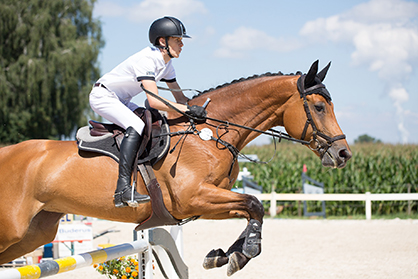Saddle Fit: an Important Aspect of Equine Performance
 By: Rob Warren, UC Davis VMTH Communications & Marketing Officer
By: Rob Warren, UC Davis VMTH Communications & Marketing Officer
While most horses that present to veterinarians with a lameness issue are certainly injured, some may just have an improper saddle that isn’t allowing them to perform to their fullest potential.
“In an examination of a horse with lameness, the saddle should always be part of that evaluation,” said Dr. Sarah le Jeune, chief of the Equine Integrative Sports Medicine Service at the UC Davis Veterinary Hospital. “Back pain is another issue. It’s a common ailment we routinely see, but many times it can be attributed to an ill-fitting saddle rather than an injury. The prevalence of improper saddle fit is high in that situation.”
Dr. le Jeune suggests that a saddle should be evaluated, not just in the isolated circumstance of the horse standing still, but also after being ridden due to the changes in fit that occur while riding. The rider can also have a dramatic influence on the fit during and after exercise.
“We recommend that horses have their saddle checked for fit multiple times a year, especially if they are going through a period where they’ve gained or lost weight,” suggests Dr. le Jeune. “A time when a horse has had a change in its exercise routine is another instance where we would advocate for a saddle check. The new routine can change the horse’s muscular stature which will affect the fit.”
As equine athletes progress through long-term workout routines, their physiques grow and change with muscle development. They will increase in size even after they have stopped growing at a certain age (like a child reaching adulthood). Similar to a weight lifter whose shirt may no longer fit due to an increase in body size, an equine athlete’s saddle may no longer fit properly due to its increased frame. It should not be expected that a horse can properly utilize the same saddle throughout its life.
 Ill-fitting saddles can alter a horse’s performance in many ways, but one of the most significant effects it can have on a horse is exerting too much pressure on its back muscles. This will cause an improper flow of blood to the muscle and cause pain. No muscle can develop and work properly without an adequate blood supply. Over time, that muscle will degenerate or atrophy. Long-term mechanical issues can set in if the muscle cannot develop properly. This is not an irreversible issue, though, if a properly fitted saddle can be substituted before the situation has reached a terminally chronic point.
Ill-fitting saddles can alter a horse’s performance in many ways, but one of the most significant effects it can have on a horse is exerting too much pressure on its back muscles. This will cause an improper flow of blood to the muscle and cause pain. No muscle can develop and work properly without an adequate blood supply. Over time, that muscle will degenerate or atrophy. Long-term mechanical issues can set in if the muscle cannot develop properly. This is not an irreversible issue, though, if a properly fitted saddle can be substituted before the situation has reached a terminally chronic point.
Dr. le Jeune recommends a saddle with an adjustable tree, which could prevent the need to purchase multiple saddles over time. The shape of the tree is what ultimately determines the fit – if the shape of the tree can’t be changed, new saddles will continually have to be used as the horse’s size changes. She also warns against using too many pads to compensate for an ill-fitting saddle. It may work for a saddle that’s too wide, but is detrimental for saddles that are too narrow.
“Ultimately, I would like to see saddle fit as a routine part of a horse’s care,” Dr. le Jeune said. “Just like getting a horse’s teeth floated once a year, owners who ride a lot should have their saddle fit checked on a routine basis. In the long run, it will help their horse’s performance and health.”










